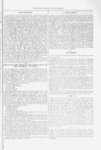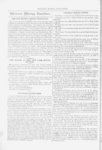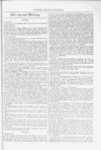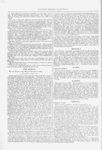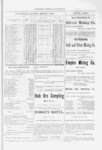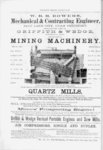| OCR Text |
Show WESTERN MINING GAZETTEER. I I I DEEP MINING. THE ALBION. this subject the Park Mining Record says: Mining will soon rank among the leading scientific industries of our country. It is only just beginning to be understood. The few shallow shafts and short tunnels scattered throughout the vast mineral region of the West arc as nothing to what the next generation will see. The few great lodes that arc now worked will yet be surpassed by greater ones. Miners will learn that to get permanent paying mines they must go down deep into the earth, Here in this camp we have one mine producing largely; but no one doubts that there are many good mines here that will only need proper development to pay handsomely. The wealth of the McHenry mine cannot be. overestimated. Its ore bodv is not so well developed as the Ontario, but it is said by those who should know to equal that great mine in richness and extent so far. For years the owners of the Ilawk. eye have endeavored to find their ore body near the surface, but have at last sensibly abandoned that idea and erected large hoisting works to with which they will sink a depth of 300 feet before they cross-cu- t The on and White Pine vein. ore have the good Utah, although they will bonanzas of at a show ore levels, the upper greater depth. The Jones Bonanza has ore in the 200 level, and would pay well for stoping The Sentinel of the 22d says that the letter to the San Francisco office given below was written some days ago, since which the main drift has been continued ten fifteen feet further into the ore body. The of fifteen feet mentioned in the Sentinel of yesterday, lias also been made since the date of the official letter. Acting Superintendent John W. Wilson writes as follows: I hasten to give you the earliest positive knowledge regarding the chamber of the ore body found on the 8th iust., in the upper level of the Albion. Our drift was running partially with the trend ot the ore body at the point of connection, and we have had very hard limestone to contend with. The drift is now wholly in ore, having penetrated it last evening for the. first time, and have run diagonally into it a distance of ten feet. Have seen enough to convince me of an extensive deposit. 'Charsetn of the ore is of a red carbonate and galena, very heavy, and I know it is of a good quality. The locality ot the strike is fifty-siabout sixty feet above our main level. In the cross-cu-t, feet 125-tocross-cufrom the runs nearly t upraise from southeast drift, the parallel with the Tiptop line (Richmond;; ore trends northwesterly and we have apparently run under a heavy portion of it. We are also finding the same character of ore in the Uncle Sam cross cut, UK) feet from the main level. It lies in bunches and seams. We are following on the track we have drifted and are now raising; have reason to it will lead us to an ore body. We are doing a great deal of work, but as yet have made no ore developments in other partB of the mine, though we meet with favorable conditions. t On i I j j j j J j i i i to the surface; but the managers are not afraid to go to the 400 level The before they begin the grand work of shipping bullion. COO 500 a or at of a friends in its mod; feet, satisfy depth Empire will, ! j j ! i ! I ; ; ; ; ; i ! I ; ( ; : ! satisfactory manne, and repay them for the heavy outlay necessary to reach such a depth. The Boss mine improves steadily as each succes- The Barrios company are not disap. sive foot in depth is reached. no in ore near the surface, nor have they ever cx-- 1 pay having pointed pected to find it there; but so confident are they that they will find it at a depth of from 100 to 300 feet, that when a working capital was placed upon the market the original owners bought it all in at a dollar per share. Is Mr. Shaughncssy worried because he has not a bonanza in the Henrietta and Monitor within a few feet of the surface? We have not mentioned near all the mines here which will in time make a noise in the world. We do not venture the assertion but say as a fact that there will be at least six mines producing bullion next season, and when they begin they will not cease soon. oV the reduction op cost the reducingORES NEARLY ONE-HAL- F. Mr. A. Bryam, now of Chicago and one of the firm of Cambell, len & Co., a gentleman well versed in the science of chemistry, has Cul-- ? just completed a very successful experiment in the smelting of the ore from the Horn Silver mine. From the presence in the ore of such bases as antimony, sulphur and arsenic, it was deemed very necessary to use a large percentage of iron ore as a flux, also to roast the ore in the open air so as to volatilize, as much as possible, the obnoxious bases before putting it through the furnace. All this was very costly, iron ore being worth from $8 to $10 per ton, and cedar wood $2 75 per cord at the 8 me) ter. As near as we can find out the charge for the furnace, before Mr. Bryam made his test, was as follows: 4 barrows of roasted ore. 1 barrow of rich or raw ore. 1 barrow oi lime. 5 barrows of iron ore. barrow of matte. i ! i j i ! : The verage cost of smelting one ton of ore was from $25 to $27. Mr. Bryam claimed that the ore could be run much cheaper. He said that the expense of roasting, the expense of iron ore and of lime could be avoided, and thereupon commenced his experiments. Although many were incredulous as to his making a success, he went bravely to work and was to be found around the furnace day and night. A nine days run proved him to be successful. After an examination of the accounts it was found that he had saved over eighty percent of both the lead and silver; that he had used less coal and "lime and but very little iron, and that it had cost the company but $15 per ton to run the ore through. His charge is reported to be as follows: 3 barrows of roasted ore. barrows of raw ore. barrows of matte. And a small amount of iron. The matte was roasted, but Mr. Bryam claims that it will flux the ore just as well before being roasted as after. The most important features in this experiment arc the saving of the expense of using wood for roasting and iron lor fluxing. About 400 cords ot cedar wood were used on an average per month for the purpose of roasting the ore and matte. That alone amounts to $1,100 per month ; then the saving in the non-usof iron ore. We would like to go into further details regarding this experiment, but as Mr. Bryam had to leave suddenly on matters of business, and as nobody seemed to know anything about his theory, and we arc not smelters, we are unable to give anything more than the above. We are sorry, for the reason that it is of the utmost importance for owners of mines containing low grade ores; for, if it is a success, and we have not only from report but from the fact that every reason to believe , it was demonstrated that the ore could be run at a cost of $15 per ton as against $25 to $27, a good practical smelter could make money in , Ibis county, for there are plenty of prospects showing ore that will as- say from 8 to 20 ounces in silver to the ton. As proof of Mr. Bryam s success, both furnaces are now being run according to his idea. Southern Utah Times, 2 3 e . , ; it-is- 'r up-rai- se x ot be-lie- 1 ve 1IE PRESS. There is a thousand dollar smile to the credit of each of you in this office, gentlemen: The Western Mining Gazetteer is the name of a new eight page paper published at Salt Lake, and devoted exclusively to the miniug interests of the Paoitio States and Territies. Vol. 1, No. 1, of which a copy lies on our table, is well gotten up and is worthy the patronage of everybody. We wish the new enterprise success. Southern Utah Times, The Western Mining Gazetteer, a new publication devoted exclusively to mining, by Mark V. Musgrove has reached our table from sheet and the first number is filled with Salt Lake. Ii is an eight-pag- e inteiesiing mining news from all over the Coast If Mark turns out the succeeding mini her of the Gazetteer, looking as well and filled to the brim with as interesting mining news as the one before us we see no reason why he should not succeed. Park Mining Record. The first number of the Western Mining Gazetteer appeared yesterday. It is a modest quarto, printed in a handsome manner and replete with information of this and other Territories whose principal industries are carried on beneath the ground. Correspondence from Southern Utah, Stockton and Yankee Fork till the first page. The second page is devoted to editorial matter, while the remaining six pages, except the last two, are filled with general mining news. The paper is under the management and editorship of Mr. Mark W. Musgrove formerly of the Yankee Fork Herald , and well known as a trenchant and sprightly writer. We welcome to the list of Tentorial papers this last venture and trust that the good it will do our mining interests will only be exceeded by the pecuniary profit it may prove to its owner Salt Lake Tribune, m qg . The Yankee York Herald, Idaho, publishes an account of the trip of a party of prospectors into the Middle Fork country. The party brought in with them several large pieces of ore from the outcropping ledges. It has the appearance of being rich in both gold and silver, and contains what at first sight appears to he sulphurct and horn silver, but the crucible tests show that the mineral is principally plumbago, with a small quantity of silver and a little gold. There is every indication of a big mineral field iri that section. The float is scattered over a largo scope of country, and it is thought that some good ledges will he np ned up on the belt. As yet no shafts have been sunk to test the characti r of tbc ores below the surface. This new mineral field is about 50 miles southwest of Cape Horn, or about 80 miles from Bonanza, ahum 50 miles from Saw Tooth District, and 18 to 25 from the old Dead Wood placer camp on the head of the Payette. From Bonanza then is a good trafi, through an open country a great, portion of the way. The mines are on the divide of the Payette and Salmon waters, and at an altitude of about 9,000 feet. The Summers Mining Company have filed articles of incorporation in Lyon county, Nevada. Trustees, A. J. RaMon, II. Summers, Edward Norton, J. I). Coughlin, James Ileron; residences, San Francisco. President, James Heron ; Vice President, A. J. Ralston ; Secretary and Treasurer, W. W. Stetson ; Superintendent, W. J . Collins. Capital stock $10,000,000. |



